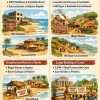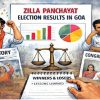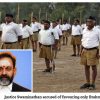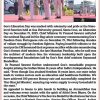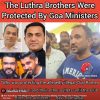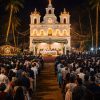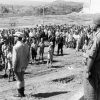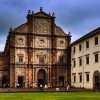Goa is abuzz with excitement as vintage bike and car owners, users, collectors and fans are decking […]
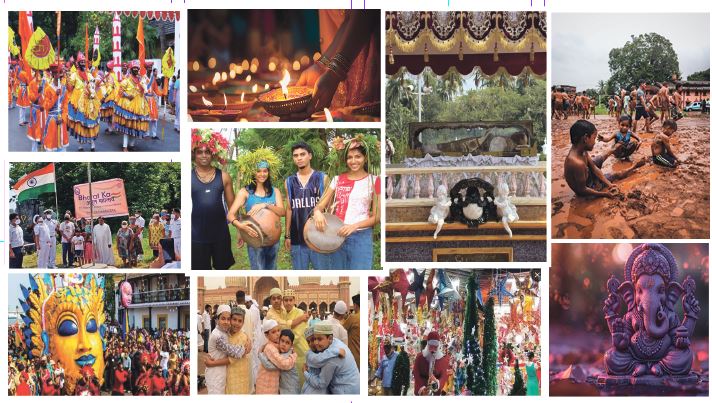
GOA AT ITS BEST IN THE FESTIVE SEASON!
Dec 21- Dec 27 2024, Stray Thoughts December 20, 2024By Rajan Narayan
AND a few stray thoughts for yet another Saturday. For a Saturday following the week when our research revealed that a Mallu, VK Krishna Menon, played the most decisive role in the Liberation of Goa. For a Saturday following the week when the magic of Christmas arrived in Goa. For a Saturday following the week when Goa’s rich music tradition is back in revival mode.
AND a few stray thoughts when our research revealed that a Mallu, V K Krishna Menon, played the most decisive role in the Liberation of Goa. Though there was tremendous pressure on India’s first prime minister, Jawaharlal Nehru, to liberate Goa, he was very reluctant. As an inheritor of the legacy of Mahatma Gandhi, Nehru was against the use of force to settle international disputes. Nehru believed that he could persuade the Portuguese to leave Goa peacefully. Nehru was strengthened in his belief by his success in persuading the French to give up the colonies of Pondicherry and Mahim.
Obviously, the major source of inspiration was the ability of Gandhi to persuade the British to leave India. The Portuguese were not cultured and civilized like the French, particularly under dictator Salazar. This was dramatized by their firing upon the satyagrahis who came from Pune to fight for Goa’s liberation.
During the last phase of Goa’s liberation, it was the Socialists led by Ram Manohar Lohia and former Union Minister of Railways of India Madhu Dandavate among others, who fought for the Liberation of Goa. The Portuguese soldiers mercilessly shot and killed Indian freedom fighters at the border, leading India to impose a block against the Portuguese regime in Goa.
By the late 60s, it was clear that the Portuguese would not leave voluntarily. It was Defense Minister Krishna Menon in the Nehru cabinet who persuaded Nehru that the armed forces should invade Goa and liberate the territory from the Portuguese. The final decision was taken at the beginning of December when Indian troops gathered in Belgaum, now Belgavi and marched into Goa. They received the green signal on December 17, 1961 and marched into Goa on three fronts.
When they heard about the invasion on orders from Salazar, the Portuguese blew up the bridges leading to Mapusa and other parts of Goa. The Indian Air Force and the Navy also played a major role in the liberation of Goa. A Portuguese destroyer was immobilized in Dona Paula in Panaji. The Portuguese broadcasting station again in Dona Paula was bombed. For the residents of Panaji, it was a very scary scene to see Canberra bombers flying very low over Panaji city.
The Dabolim airport was one of the major targets of the Indian Air Force. Manuel António Vassalo e Silva who was the commander of the Portuguese armed forces made a last stand at Vasco after abandoning Panaji.
The Indian army reached Betim but could not cross the Mandovi River. The Signal Battalion which still has its headquarters near the Panaji market, built bailey bridges for transporting the troops across. A recent book by Ralph Dsouza called “Change of Guard” reveals that the then Bishop of Goa José Vieira Alvernaz managed to persuade the Portuguese general to surrender to avoid bloodshed. Manuel António Vassalo e Silva who was deported to Portugal was treated very badly by Salazar. The truth is that the Portuguese were no match for the Indian armed forces.
Just before liberation, the Portuguese bank Banco Ultra Marina fled with all the gold deposited by Goans for taking loans. The gold was recovered decades later thanks to the intervention of the then minister of state for finance, Eduardo Faleiro. It is not true that the Indian army soldiers tried to shift the relics of St Francis Xavier from the Bom Jesus Basilica. The relics were treated with the greatest respect. But in an atmosphere of rumors of Indian aviation the feast of Goecho Saib was celebrated on December 3, 1961 on a very low key. However, Christmas which came six days after Liberation, was celebrated in the usual Goan tradition.
The Western powers like the United States and the United Kingdom were scandalized over Nehru’s invasion of Goa. When the then President John F Kennedy of USA was informed he is reported to have commented, “The priest was caught in the hen house” — a reference to the pious Nehru resorting to violence. Portugal did not accept the Liberation of Goa for over two decades. Which is why they continue to consider Goans born in Goa as citizens of Portugal. This was the origin of granting visas and Portuguese citizenship to all those born before Liberation and also to their sons and grandsons.
It is an irony of history that the poorest country in Europe dared to defy mighty India. Incidentally, Bombay was part of Portuguese India till it was gifted as dowry, when Portuguese Princess Catherine of Braganza married King Charles II of England.
CHRISTMAS MAGIC
AND a few stray thoughts on the magic of Christmas in Goa. When I first came to Goa in October 1983, I experienced my first Christmas. Christmas arrived at my basement flat in Dona Paula with a group of local boys and girls singing carols at my door. It was a common sight in the 80s to have groups of young people wearing Santa Claus red caps on going around singing carols. Bethlehem cribs depicting the birth of Jesus came up at every corner in Goa.
The master in the art of making cribs was and is of course, Francisco Martins, who also designed all the prize-winning Republic Day floats. After Liberation the carnival was revived with Gajanand Shirodkar of the Real Group sponsoring the first King Momo float.
I spent my first Christmas with my old Mumbai friends, Diana and Edwin Pinto who had moved to Nagve or Nagoa near Verna where they had built a small cottage for themselves. I recall that on Christmas day we went to the then Oberoi Resort at Bogmalo beach.
Since most of the guests of the hotel had feasted on the Christmas eve dinner, Anand Chatterjee, the general manager at the Oberoi had a special mountain of fruit for those who did not want to have Christmas day lunch. But I remember this was my first exposure to a turkey lunch which I had to pass up for I was and am still a vegetarian making only eggs an exception.
The Jingle Bells tunes jingled all over Goa and in keeping with the tradition, I supported my staff in the OHeraldo to put up a Christmas tree and even bought some presents for the staff. I continued the tradition in Goan Observer later when we put up a Christmas tree with the usual razzmatazz decorations. The Forest department at Campal supplies branches of pine or casuarinas tree even to this day to those who seek a natural tree for a Christmas tree and not a synthetic plastic tree.
Christmas in Goa is a family affair and outsiders are seldom invited. Thanks to my friend Fr Oscar Quadros I spent Christmas day with the Gracious family in Loutolim in their ancestral house where there was a stuffed piglet with an apple in its mouth. I was privileged to be invited to several Catholic homes for Christmas lunch. I had my last Christmas lunch with advocate Nigel da Costa Frias’ family at Nagali Hills a couple of years ago.
Every year Christmas time we got invited for cake-mixing ceremonies at Cidade de Goa, the Taj and the Marriott Resort; alas, no longer. But in any case I have not been able to go out much during the last two years because I am still recovering from TB of the spine. This year though I hope to spend Christmas day at the Marriott if I am able to persuade my old friend Dattaraj Salgaocar to give me a table.
The ideal place to attend Christmas midnight mass if you stay in Panaji is at the beautiful very old chapel at the Goa Raj Bhavan at Dona Paula. One occasion I recall the flavor of the hot coffee and cake served to all after the mass and it was quite freezing cold in the early hours of the morning under the chilly night sky, this was when the Catholic Jamir was the governor of Goa.
GOA’S RICH MUSIC
AND a few stray thoughts on the rich music tradition of Goa before and after Liberation. Particularly, the Goan Catholics who are deeply involved in music inspired perhaps by church choirs over the years. Indeed, before Liberation, we remember the church choirs teaching both instrumental and vocal music and creating major sources of employment for young Goans.
The CMM business empire was built on gold coins earned by Cosme Fernandes as a drummer in the Portuguese army in Angola in Africa. A large contingent of African soldiers from Angola were brought to Goa before the Liberation to defend the Portuguese territory. Ralph D’souza’s book offers rare photographs of the Angola soldiers at Bom Jesus Basilica.
When I came to Goa in 1983 I was first introduced to the organ, when I listened to Linda Dias playing it during lunch at the Mandovi Hotel. Virtually every Catholic household has an organ though not necessarily a grand piano. The oldest functioning grand piano is still at the Rachol Church in south Goa. The Furtado’s, who are pioneers in the sale of musical instruments, still offer the best pianos and musical instruments in the world, including the Steinway piano.
Close to the “OHeraldo” office in San Tome Fr Laurdino Barreto used to conduct classes on the organ and one could hear the sweet notes every time one passed the chapel. The “OHeraldo” used to have its anniversary mass at the St Tome Chapel. Fortunately, I would appreciate western classic music as I have listened to masters Zubin Mehta and Yehudi Menuhin, internationally reputed conductors of the world’s best orchestras. And yes, I also used to enjoy going to the churches especially for Christmas, just to listen to the church choir.
More recently the Stuti choral and string ensemble offered a fantastic experience with their 100-member string orchestra. Even more impressive is Goa’s tradition of western music which I was exposed to courtesy the Goan bands in Bombay where Chris Perry and his protégé Lorna Cordeiro started their music careers.
My early years in Goa I had the good fortune to listen to a young Remo Fernandes at the centenary celebrations of the Mormugoa Port Trust. Perhaps the best Goan music was played at the nightclub Haystack at Arpora, started by singer August Braganza. All of Goa’s singers including the Valadares sisters, architect Lucio Miranda and Remo Fernandes himself, used to jam up for the festival of music at Arpora.
Goa is one of the few places in the country where you can still listen to live music bands. One of the best bands is led by Ashley Fernandes who is a veteran of band music over two decades. Interestingly, one of the most entertaining singers, who is comfortable with both Portuguese and Goan songs, is Dr Francisco Colaco of the Margao’s singing family, because this includes his wife Fernanda and daughters Elaine and Anabelle. Elaine is an investment banker who worked with Goldman Sachs. Amongst my favorite singers were Dilip Chico who performed at a small wedding reception way back in 2001, when I got married to Pankajbala Tara Patel on the terrace of my friend Vaidhee’s “Sea View” apartment at Dona Paula. The sound of music continues to embrace Goa, particularly during Christmas and New Year when it touches new heights.
GOODBYE USTAD ZAKIR HUSSAIN
AND a last stray thought dedicated to the memory of Ustad Zakir Hussain who passed on recently at 71 years of age in California in USA. Zakir Hussain had the tabla in his genes as he was the son of Ustad Alla Rakha. Zakir was a child prodigy who could beat the taal of the tabla when he was two years old. He studied at the St Michael School in Mahim in Mumbai where he lived. Zakir took the tabla to the highest international level in the tradition of Ravi Shankar, who was accompanied by Ustad Alla Rakha, and they performed the world over.
Zakir Hussain was a serious classical musician and a total wizard at getting the tabla drums to produce music to fill the senses. He knew how to cater to a young generation and inspire young aspiring musicians to acquire a love for the tabla drums. He would take time off from serious raag playing to make his tabla trot like a horse or even conjure up women engaged in fighting. I’ve had the privilege of hearing Zakir Husain performing with his father Ustad Alla Rakha at the Rang Bhavan in Mumbai.
I’ve also attended every concert of Zakir Husain when he performed – rarely — at the Kala Academy in Mumbai. To watch and listen to Zakir was to experience poetry in motion. He played his first concert at the age of seven, later became a member of the international band Shakti and jammed with John McLaughlin, Vikku Vinayakram and L Shankar in the 1970s. Zakir also acted in some films and provided the music for Ivory Merchant’s “Heat and Dust.” He even auditioned for the role of the young Prince Salim in K Asif’s film “Mughal-e-Azam.”
The ustad of ustads died of pulmonary fibrosis complication in a hospital in San Francisco where he had been residing for the last three decades. Farewell, Zakir Hussain, the world of music will miss you and is poorer without you.S

